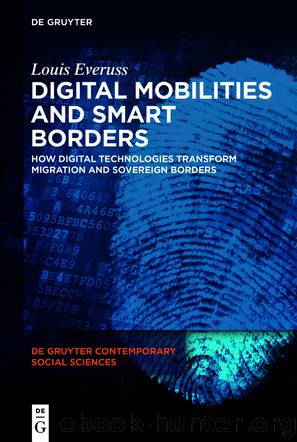Digital Mobilities and Smart Borders (for Raymond Rhine) by Louis Everuss

Author:Louis Everuss
Language: eng
Format: epub
Publisher: De Gruyter
Published: 2024-08-05T18:21:38.540000+00:00
Digital technologies as essential tools of travel
As indicated above, the technology that is most frequently studied as a digital migration tool is the mobile smart phone (Alencar, 2020; Dekker et al., 2018; Mezzadra, 2017; Noori, 2022a). Smart phones are small and portable computers that, in addition to standard telecommunication functionality, provide the necessary hardware and interface for a wide array of travel related applications. Smart phones have attracted significant scholarly interest because they have become almost omnipresent in international travel, including for example, enforced migration. Indeed, 95 percent of the Syrian and Iraqi refugees who entered Europe in 2015 relied on a smart phone at some point during their journey (Gough & Gough, 2019, p. 90). And the usage of smart phones does not end when enforced migrants reach a destination as they are used to navigate foreign settings. Back in 2016, the UNHCR estimated that â68â% of refugees living in urban centers have access to an internet-enabled phone, with the vast majority prioritizing mobile ownership and connectivity as crucial for their safetyâ (Alencar, 2020, p. 2).
While mobile phones are used for many important travel purposes, for enforced migrants it is still their capacity to enable communication with other migrants and migrant âhelpersâ that is of the most significance (Borkert et al., 2018). This communication increasingly occurs through data networks and VoIP services like Skype or Viber (Dekker et al., 2018), or via text and multimedia messaging on social media sites and encrypted messaging apps (Borkert et al., 2018; Dekker et al., 2018). Max Schuab (2012, p. 126) found that trans-Saharan migrants use such forms of communication to âdraw on the unprecedented accessibility of contacts equipped with mobile phones to tie together novel, geographically expansive networksâ.
Another important feature of smartphones for enforced migrations is the capabilities they offer to research journeys and destinations. In a survey ascertaining the information needs of Syrian refugees, Borkert et al. (2018, p. 6) found that migrants used technology to ascertain the well-being of family in their home country, to obtain news about their country of origin, to learn new languages, and study the culture of their destination country. The information provided by smart phone usage is not just used for planning purposes, but also real time and reflexive actions and decision making. For example, GPS capabilities and mapping applications are employed by enforced migrants to navigate and to request assistance (Jones et al., 2017, p. 5). Simon Noori (2022a) has found that the ability to read GPS coordinates off a smart phone played a pivotal role for migrants crossing the Aegean Sea from Turkey to Greece in 2015 by enabling them to request assistance from coastguard authorities and refugee advocates. Other research suggests mobile mapping applications increase the mobility of Afghan, Iranian, and Syrian refugees, who see mapping apps as essential phone-based tools (Alencar, 2020).
There is thus a diverse range of ways that enforced migrants use smart phones that has led this technology to become, in Marie Gillespie et al.âs words (2018, p. 1), âlifelines, as important as water and food.
Download
This site does not store any files on its server. We only index and link to content provided by other sites. Please contact the content providers to delete copyright contents if any and email us, we'll remove relevant links or contents immediately.
Whiskies Galore by Ian Buxton(41720)
Introduction to Aircraft Design (Cambridge Aerospace Series) by John P. Fielding(33017)
Small Unmanned Fixed-wing Aircraft Design by Andrew J. Keane Andras Sobester James P. Scanlan & András Sóbester & James P. Scanlan(32685)
Aircraft Design of WWII: A Sketchbook by Lockheed Aircraft Corporation(32164)
Craft Beer for the Homebrewer by Michael Agnew(18082)
Turbulence by E. J. Noyes(7895)
The Complete Stick Figure Physics Tutorials by Allen Sarah(7265)
The Institute by Stephen King(6860)
Kaplan MCAT General Chemistry Review by Kaplan(6823)
The Thirst by Nesbo Jo(6759)
Bad Blood by John Carreyrou(6477)
Modelling of Convective Heat and Mass Transfer in Rotating Flows by Igor V. Shevchuk(6354)
Learning SQL by Alan Beaulieu(6159)
Weapons of Math Destruction by Cathy O'Neil(6085)
Man-made Catastrophes and Risk Information Concealment by Dmitry Chernov & Didier Sornette(5878)
Permanent Record by Edward Snowden(5682)
Digital Minimalism by Cal Newport;(5588)
Life 3.0: Being Human in the Age of Artificial Intelligence by Tegmark Max(5405)
iGen by Jean M. Twenge(5326)
